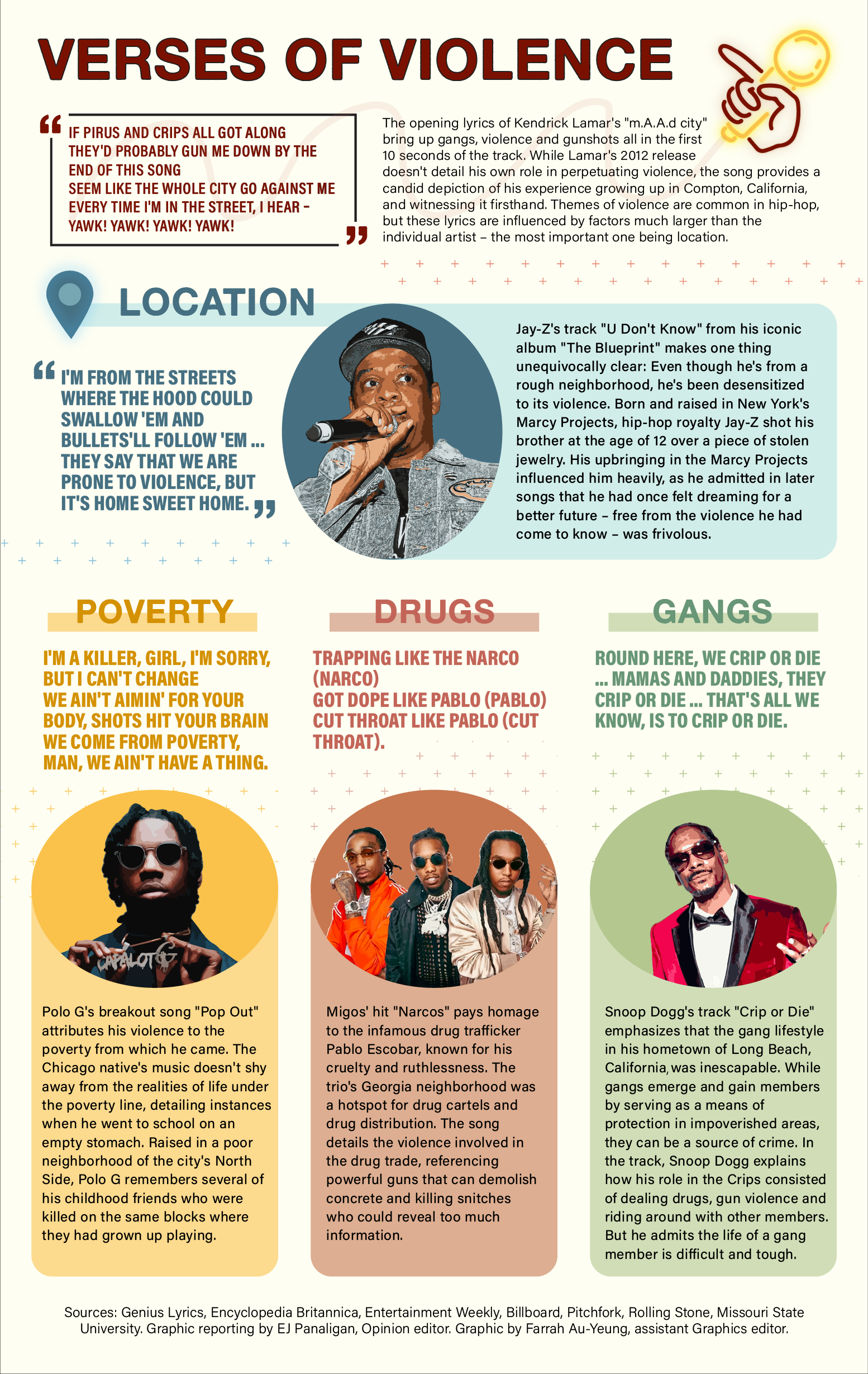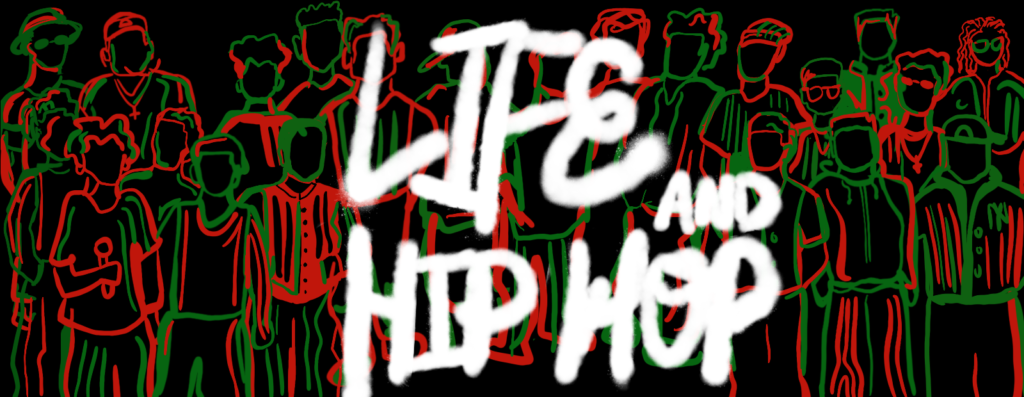Life and Hip-Hop: Song narratives, themes build upon stories of crime and violence


By EJ Panaligan
Oct. 21, 2020 10:03 p.m.
The impact of music extends far beyond the play and pause buttons. Formed in the 1970s as an underground movement, hip-hop has expanded into various art forms and musical sub-genres – with rap specifically being one of the most popular musical styles among today’s youth. In “Life and Hip-Hop,” columnists Natalie Brown and EJ Panaligan explore and analyze how hip-hop intersects with and influences everyday aspects of life.

“And I’m from the murder capital where they murder for capital/ Heard about at least three killings this afternoon/ Looking at the news like, ‘Damn! I was just with him after school’/ No shop class, but half the school got a tool.”
The opening lines to Kanye West’s first verse in “Murder to Excellence,” a 2011 song with longtime collaborator Jay-Z, paint a harrowing image of the inner-city violence in West’s Chicago hometown. Jay-Z’s verse mirrors a similar experience, comparing his fight for survival to crabs fighting each other to escape a barrel during a tumultuous, crime-ridden Brooklyn, New York, upbringing. These experiences are not glamorous by any means nor do they make the song an easy listen, but they are especially significant stories to share on wax.
And unfortunately, West’s and Jay-Z’s stories aren’t works of fiction. Their stories are reflective of a frightening reality that many individuals – some who may never get anywhere close to a mic – experience while trying to survive in low-income neighborhoods of metropolitan cities. Chicago has averaged 564 homicides a year since 1957, which, despite a decline in recent years, still exceed other cities’ numbers of shooting incidents. During Jay-Z’s early adulthood years, murders in New York City surged 17.8% from 1989 to 1990.
However, hip-hop and rap help turn these statistics into stories for those who never lived to tell their own.
Violence and crime tend to be pertinent, common topics within this musical realm, whether told as cautionary tales or glamorized as an attractive lifestyle. The effects of deep-seated systemic racism and oppression have drastically limited opportunities for communities of color, the same communities many rappers come from – sometimes forcing them or those around them to resort to less-than-legitimate measures to survive.
[Related: Life and Hip-Hop: Nipsey Hussle’s legacy of resisting gentrification in birthplaces of music]
No matter how it’s conveyed, crime and violence remains a fixture in rap artists’ lyricism and storytelling because they are simply the reality many artists face in low-income neighborhoods, said Kyle Mays, an assistant professor of African American studies, American Indian studies and history.
“Hip-hop has existed within the context of the rise in mass incarceration since the 1970s, but hip-hop itself is not to blame for that,” Mays said. “It’s a function and representation, in some capacity, of what’s happening in poor, working class urban communities.”
Through the lens of mass incarceration, people of color are an overrepresented portion of the 2.3 million individuals incarcerated in the United States – with Black people accounting for 40% of the incarcerated population while only making up 13% of the total U.S. population. The school-to-prison pipeline is a direct contributor to those figures, as school districts with concentrated areas of poverty continue to receive less state funding. With less funding in education, communities of color are disadvantaged in pursuing traditional careers, forcing them to establish streams of income elsewhere.
Compton, California, rapper Kendrick Lamar is no stranger to highlighting the fight for financial stability in his music. His 2012 song “Money Trees” tells the story of him and his friends plotting a home invasion on a rich family attempting to make quick money in pursuit of comfort and security. A couple years later, his 2015 song “Institutionalized” continues the narrative of discussing the negative effects money has on fueling one’s desire and greed, especially when some have little to nothing to their name.
[Related: Life and Hip-Hop: Artists draw inspiration from lived experiences and hometowns]
Outside financial matters, Mays said rappers have been more interested in reflecting a masculinized idea of what it means to come from tough hometowns, even after they have moved out of them.
“(Rappers) grew up poor and as they get more money and fame, they’re still talking about certain areas and concepts, but they’re living in different environments,” Mays said. “Do they still even have legitimate stories about those particular areas at a certain point, and when does it become just posturing?”
Some artists tend to glamorize a hood lifestyle that could include potentially traumatic experiences, largely because the genre’s relationship with violence remains inseparable. Rappers Pop Smoke and Nipsey Hussle were two recent victims of gun violence, while Juice WRLD and Mac Miller were recent victims of drug overdoses – lasting effects of the 1980s crack cocaine epidemic that negatively affected Black communities and perpetuated a culture of drug abuse and glamorization in hip-hop.
Because of these tragic incidents, it’s important that rappers like Jay-Z and West continue to speak the truths of their upbringings into the microphone. When these Black artists survive such agonizing experiences long enough to tell their stories, they’re able to use their financial platforms and credibility as philanthropists to give back to their communities. West co-founded the Art of Culture Inc. charity in Chicago to help foster creative potential within the city’s youth, and Jay-Z established the Shawn Carter Foundation to help younger individuals pursue educational opportunities in higher learning.
The truth is hip-hop artists can only speak to the pain they’ve lived through.
Violence and crime in hip-hop is not a pleasant topic, but it was never meant to be.

